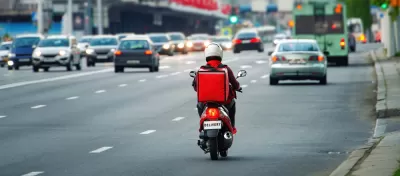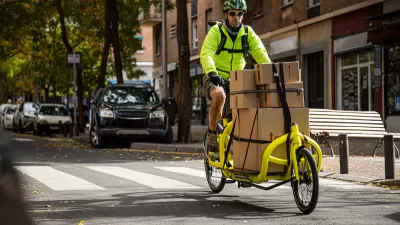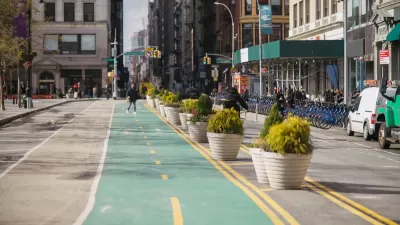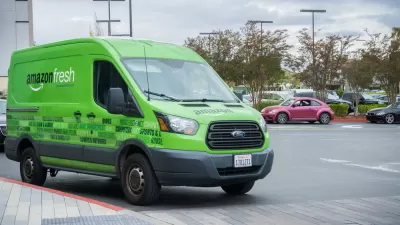Facilitating the use of micromobility devices for the last mile of urban deliveries can reduce congestion, lower emissions, and take bigger vehicles off small neighborhood roads.

A whitepaper commissioned by Uber describes the potential for micromobility to improve last-mile delivery of goods, which, for the most part, are currently delivered by cars and trucks. As reported by Charles Pekow in Smart Cities Dive, “Use of micromobility vehicles for those last-mile deliveries can bring a variety of benefits in urban areas — benefits some cities are already realizing, the whitepaper states.”
While these devices aren’t practical everywhere, the paper notes five strategies cities can implement to improve infrastructure for micromobility deliveries:
- Make micromobility users feel safe by taking Vision Zero and Safe Systems approaches to road infrastructure, regulations and communications.
- Facilitate safe and easy pick-up and drop-off of deliveries such as through curbside management strategies and building codes.
- Provide policy leadership in support of micromobility such as net zero emissions goals and innovation incubators.
- Support remoding of last-mile deliveries through micro-logistics hubs and other efforts.
- Test and scale ideas that work.
The article notes that bike delivery is nothing new, dating back more than a hundred years. “The whitepaper documents how other cities have successfully implemented bike delivery services. For example, after Toronto improved its cycling network, Uber Eats saw its bike deliveries in that city increase 40% from 2019 and 2020, Uber said. A 2019 project in New York City more than doubled cargo bike deliveries in the covered area, with each cargo bike that replaced a van or box truck resulting in about 7 tons fewer of annual CO2 emissions.”
FULL STORY: 5 strategies to advance micromobility for urban last-mile delivery: report

Trump Administration Could Effectively End Housing Voucher Program
Federal officials are eyeing major cuts to the Section 8 program that helps millions of low-income households pay rent.

Planetizen Federal Action Tracker
A weekly monitor of how Trump’s orders and actions are impacting planners and planning in America.

Ken Jennings Launches Transit Web Series
The Jeopardy champ wants you to ride public transit.

Crime Continues to Drop on Philly, San Francisco Transit Systems
SEPTA and BART both saw significant declines in violent crime in the first quarter of 2025.

How South LA Green Spaces Power Community Health and Hope
Green spaces like South L.A. Wetlands Park are helping South Los Angeles residents promote healthy lifestyles, build community, and advocate for improvements that reflect local needs in historically underserved neighborhoods.

Sacramento Plans ‘Quick-Build’ Road Safety Projects
The city wants to accelerate small-scale safety improvements that use low-cost equipment to make an impact at dangerous intersections.
Urban Design for Planners 1: Software Tools
This six-course series explores essential urban design concepts using open source software and equips planners with the tools they need to participate fully in the urban design process.
Planning for Universal Design
Learn the tools for implementing Universal Design in planning regulations.
Heyer Gruel & Associates PA
Ada County Highway District
Institute for Housing and Urban Development Studies (IHS)
City of Grandview
Harvard GSD Executive Education
Toledo-Lucas County Plan Commissions
Salt Lake City
NYU Wagner Graduate School of Public Service





























